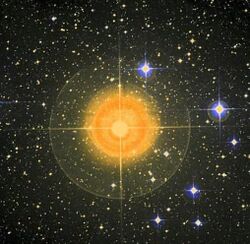Astronomy:HD 63032
From HandWiki
Short description: Binary star system in the constellation Puppis
| Observation data Equinox J2000.0]] (ICRS) | |
|---|---|
| Constellation | Puppis |
| Right ascension | 07h 45m 15.29642s[1] |
| Declination | −37° 58′ 06.8998″[1] |
| Apparent magnitude (V) | 3.61[2] |
| Characteristics | |
| Spectral type | K2.5Ib-IIa(K5IIa) + B9V[3] |
| Apparent magnitude (U) | 7.06[2] |
| Apparent magnitude (B) | 5.34[2] |
| Apparent magnitude (R) | 2.26[2] |
| Apparent magnitude (I) | 1.26[2] |
| Apparent magnitude (J) | 0.68[2] |
| Apparent magnitude (H) | -0.075 ± 0.220[4] |
| Apparent magnitude (K) | -0.47[4] |
| U−B color index | 1.72 |
| B−V color index | 1.73 |
| Astrometry | |
| Radial velocity (Rv) | 16.83 ± 0.14[5] km/s |
| Proper motion (μ) | RA: -10.18±0.18[1] mas/yr Dec.: 6.34±0.21[1] mas/yr |
| Parallax (π) | 2.9460 ± 0.1482[6] mas |
| Distance | 1,110 ± 60 ly (340 ± 20 pc) |
| Details | |
| Mass | 9.8 ± 2.1/2.8 ± 0.2[citation needed] M☉ |
| Radius | 202 ± 25/2.4 ± 0.1[citation needed] R☉ |
| Luminosity | 9600 ± 1700/65 ± 4[citation needed] L☉ |
| Temperature | A:4000 ± 150[citation needed]/B:10,200 ± 300[7] K |
| Other designations | |
| Database references | |
| SIMBAD | data |
c Puppis, also known as HD 63032 and HR 3017, is a spectroscopic binary star[3] in the constellation Puppis. Its apparent magnitude is 3.61.[2] Located around 347 parsecs (1,130 ly) distant, the primary is an orange-red bright giant or supergiant of spectral type K2.5Ib-IIa or K5IIa,[3] while the secondary, discovered in 1983,[7] is a blue main-sequence star of spectral type B9V.[3] The system is the brightest member of the open cluster NGC 2451, over two magnitudes brighter than every other star in the cluster. As the turnoff point of the cluster is currently around B7, the parameters of the system fit with cluster membership.[7]
References
- ↑ 1.0 1.1 1.2 1.3 van Leeuwen, F. (November 2007). "Validation of the new Hipparcos reduction". Astronomy and Astrophysics 474 (2): 653–664. doi:10.1051/0004-6361:20078357. Bibcode: 2007A&A...474..653V.
- ↑ 2.0 2.1 2.2 2.3 2.4 2.5 2.6 Ducati, J. R. (2002). "VizieR Online Data Catalog: Catalogue of Stellar Photometry in Johnson's 11-color system". CDS/ADC Collection of Electronic Catalogues 2237: 0. Bibcode: 2002yCat.2237....0D.
- ↑ 3.0 3.1 3.2 3.3 Eggleton, P. P.; Tokovinin, A. A. (September 2008). "A catalogue of multiplicity among bright stellar systems". Monthly Notices of the Royal Astronomical Society 389 (2): 869–879. doi:10.1111/j.1365-2966.2008.13596.x. Bibcode: 2008MNRAS.389..869E.
- ↑ 4.0 4.1 Cutri, Roc M.; Skrutskie, Michael F.; Van Dyk, Schuyler D.; Beichman, Charles A.; Carpenter, John M.; Chester, Thomas; Cambresy, Laurent; Evans, Tracey E. et al. (2003). "VizieR Online Data Catalog: 2MASS All-Sky Catalog of Point Sources (Cutri+ 2003)". CDS/ADC Collection of Electronic Catalogues 2246: II/246. Bibcode: 2003yCat.2246....0C. http://vizier.u-strasbg.fr/viz-bin/VizieR?-source=II/246.
- ↑ Mermilliod, J. C.; Mayor, M.; Udry, S. (2008), "Red giants in open clusters. XIV. Mean radial velocities for 1309 stars and 166 open clusters", Astronomy and Astrophysics 485 (1): 303–314, doi:10.1051/0004-6361:200809664, Bibcode: 2008A&A...485..303M, https://www.aanda.org/articles/aa/pdf/2008/25/aa09664-08.pdf
- ↑ Brown, A. G. A. (2021). "Gaia Early Data Release 3: Summary of the contents and survey properties". Astronomy & Astrophysics 649: A1. doi:10.1051/0004-6361/202039657. Bibcode: 2021A&A...649A...1G. Gaia EDR3 record for this source at VizieR.
- ↑ 7.0 7.1 7.2 Groote, D.; Reimers, D. (1983). "Detection of a late B star companion of the bright cluster giant c Pup = HD 63032". Astronomy and Astrophysics 119 (2): 319–320. Bibcode: 1983A&A...119..319G.
 |


